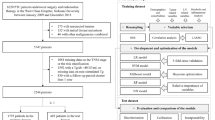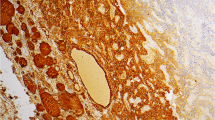Abstract
Background
Currently, a large proportion of individuals undergo thyroidectomy as a diagnostic procedure for cancer. The objective of this work was to evaluate the molecular phenotype of differentiated thyroid cancer (DTC) and benign thyroid lesions to identify molecular markers that allow for accurate thyroid cancer diagnosis.
Methods
Tissue microarrays consisting of 100 benign and 105 malignant thyroid lesions, plus 24 lymph node samples, were stained for a panel of 57 molecular markers. Significant associations between marker staining and tumor pathology (DTC versus benign) were determined using contingency table and Mann-Whitney U (MU) tests. A Random Forests classifier algorithm was also used to identify useful/important molecular classifiers.
Results
Of the 57 diagnostic markers evaluated 35 (61%) were significantly associated with a DTC diagnosis after multiple testing correction. Of these, in DTC compared with benign thyroid tumors, 8 markers were downregulated and 27 upregulated. The most significant markers for DTC diagnosis were: Galectin-3, Cytokeratin 19, Vascular Endothelial Growth Factor, Androgen Receptor, p16, Aurora-A, and HBME-1. Using the entire molecular marker panel, a Random Forests algorithm was able to classify tumors as DTC or benign with an estimated sensitivity of 87.9%, specificity of 94.0%, and an accuracy of 91.0%.
Conclusion
Evaluation of the DTC and benign thyroid tumor molecular phenotype has allowed for identification of a marker panel, composed of both established and novel markers, useful for thyroid cancer diagnosis. These results suggest that further study of the molecular profile of thyroid tumors is warranted, and a diagnostic molecular marker panel may potentially improve patient selection for thyroid surgery.




Similar content being viewed by others
References
Gharib H, Papini E. Thyroid nodules: clinical importance, assessment, and treatment. Endocrinol Metab Clin North Am 2007; 36:707–35
Davies L, Welch HG. Increasing incidence of thyroid cancer in the United States, 1973–2002. JAMA 2006; 295:2164–7
Gharib H. Fine-needle aspiration biopsy of thyroid nodules: advantages, limitations, and effect. Mayo Clin Proc 1994; 69:44–9
Ravetto C, Colombo L, Dottorini ME. Usefulness of fine-needle aspiration in the diagnosis of thyroid carcinoma: a retrospective study in 37,895 patients. Cancer 2000; 90:357–63
Goellner JR, Gharib H, Grant CS, et al. Fine needle aspiration of the thyroid, 1980 to 1986. Acta Cytol 1987; 31:587–90
Wiseman SM, Baliski C, Irvine R, et al. Hemithyroidectomy: the optimal initial surgical approach for individuals undergoing surgery for a cytological diagnosis of follicular neoplasm. Ann Surg Oncol 2006; 13:425–32
Melck A, Bugis S, Baliski C, et al. Hemithyroidectomy: the preferred initial surgical approach for management of Hurthle cell neoplasm. Am J Surg 2006; 191:593–7
Segev DL, Clark DP, Zeiger MA, et al. Beyond the suspicious thyroid fine needle aspirate. A review. Acta Cytol 2003; 47:709–22
Chen H, Zeiger MA, Clark DP, et al. Papillary carcinoma of the thyroid: can operative management be based solely on fine-needle aspiration? J Am Coll Surg 1997: 184:605–10
Parker RL, Huntsman DG, Lesack DW, et al. Assessment of interlaboratory variation in the immunohistochemical determination of estrogen receptor status using a breast cancer tissue microarray. Am J Clin Pathol, 2002;117:723–8
Wiseman SM, Griffith OL, Deen S, et al. Identification of molecular markers altered during transformation of differentiated into anaplastic thyroid carcinoma. Arch Surg 2007: 142:717–29
Benjamini Y, Hochberg Y. Controlling the false discovery rate: a practical and powerful approach to multiple testing. J R Stat Soc 1995; 57:289–300
Rodrigo JP, Rinaldo A, Devaney KO, et al. Molecular diagnostic methods in the diagnosis and follow-up of well-differentiated thyroid carcinoma. Head Neck 2006; 28:1032–9
Carroll NM, Carty SE. Promising molecular techniques for discriminating among follicular thyroid neoplasms. Surg Oncol 2006; 15:59–64
Griffith OL, Melck A, Jones SJ, et al. Meta-analysis and meta-review of thyroid cancer gene expression profiling studies identifies important diagnostic biomarkers. J Clin Oncol 2006; 24:5043–51
Kebebew E, Peng M, Reiff E, et al. Diagnostic and extent of disease multigene assay for malignant thyroid neoplasms. Cancer 2006; 106:2592–7
Foukakis T, Gusnanto A, Au AY, et al. A PCR-based expression signature of malignancy in follicular thyroid tumors. Endocr Relat Cancer 2007; 14:381–91
Fowler LJ, Lachar WA. Application of immunohistochemistry to cytology. Arch Pathol Lab Med 2008; 132:373–83
de Matos PS, Ferreira AP, de Oliveira Facuri F, et al. Usefulness of HBME-1, cytokeratin 19 and galectin-3 immunostaining in the diagnosis of thyroid malignancy. Histopathology 2005; 47:391–401
Prasad ML, Pellegata NS, Huang Y, et al. Galectin-3, fibronectin-1, CITED-1, HBME1 and cytokeratin-19 immunohistochemistry is useful for the differential diagnosis of thyroid tumors. Mod Pathol 2005; 18:48–57
Barroeta JE, Baloch ZW, Lal P, et al. Diagnostic value of differential expression of CK19, Galectin-3, HBME-1, ERK, RET, and p16 in benign and malignant follicular-derived lesions of the thyroid: an immunohistochemical tissue microarray analysis. Endocr Pathol 2006; 17:225–34
Park YJ, Kwak SH, Kim DC, et al. Diagnostic value of galectin-3, HBME-1, cytokeratin 19, high molecular weight cytokeratin, cyclin D1 and p27(kip1) in the differential diagnosis of thyroid nodules. J Korean Med Sci 2007; 22:621–8
Liu FT, Rabinovich GA. Galectins as modulators of tumour progression. Nat Rev Cancer 2005; 1:29–41
Califice S, Castronovo V, Van Den Brule F. Galectin-3 and cancer (Review). Int J Oncol 2004; 25:983–92
Gasbarri A, Martegani MP, Del Prete F, et al. Galectin-3 and CD44v6 isoforms in the preoperative evaluation of thyroid nodules. J Clin Oncol 1999; 17:3494–502
Orlandi F, Saggiorato E, Pivano G, et al.: Galectin-3 is a presurgical marker of human thyroid carcinoma. Cancer Res 1998; 58:3015–20
Bartolazzi A, Gasbarri A, Papotti M, et al. Application of an immunodiagnostic method for improving preoperative diagnosis of nodular thyroid lesions. Lancet 2001; 357:1644–50
Mehrotra P, Okpokam A, Bouhaidar R, et al. Galectin-3 does not reliably distinguish benign from malignant thyroid neoplasms. Histopathology 2004; 45:493–500
Sanabria A, Carvalho AL, Piana de Andrade V, et al. Is galectin-3 a good method for the detection of malignancy in patients with thyroid nodules and a cytologic diagnosis of “follicular neoplasm”? A critical appraisal of the evidence. Head Neck 2007; 29:1046–54
Sahoo S, Hoda SA, Rosai J, et al. Cytokeratin 19 immunoreactivity in the diagnosis of papillary thyroid carcinoma: a note of caution. Am J Clin Pathol 2001; 116:696–702
Rorive S, Eddafali B, Fernandez S, et al. Changes in galectin-7 and cytokeratin-19 expression during the progression of malignancy in thyroid tumors: diagnostic and biological implications. Mod Pathol 2002; 15:1294–301
Nasser SM, Pitman MB, Pilch BZ, et al. Fine-needle aspiration biopsy of papillary thyroid carcinoma: diagnostic utility of cytokeratin 19 immunostaining. Cancer 2000; 90:307–11
Lin JD, Chao TC. Vascular endothelial growth factor in thyroid cancers. Cancer Biother Radiopharm 2005; 20:648–61
Lewy-Trenda I, Wierzchniewska-Ławska A. Expression of vascular endothelial growth factor (VEGF) in human thyroid tumors. Pol J Pathol 2002; 53:129–32
Huang SM, Lee JC, Wu TJ, et al. Clinical relevance of vascular endothelial growth factor for thyroid neoplasms. World J Surg 2001; 25:302–6
Jubb AM, Pham TQ, Hanby AM, et al. Expression of vascular endothelial growth factor, hypoxia inducible factor 1alpha, and carbonic anhydrase IX in human tumours. J Clin Pathol 2004; 57:504–12
Kebebew E, Peng M, Reiff E, et al. Diagnostic and prognostic value of cell-cycle regulatory genes in malignant thyroid neoplasms. World J Surg 2006; 30:767–74
de la Torre NG, Buley I, Wass JA, et al. Angiogenesis and lymphangiogenesis in thyroid proliferative lesions: relationship to type and tumour behaviour. Endocr Relat Cancer 2006; 13:931–44
Ramsden JD. Angiogenesis in the thyroid gland. J Endocrinol 2000; 166:475–80
Ulisse S, Baldini E, Toller M, et al. Transforming acidic coiled-coil 3 and Aurora-A interact in human thyrocytes and their expression is deregulated in thyroid cancer tissues. Endocr Relat Cancer 2007; 14:827–37
Ulisse S, Delcros JG, Baldini E, et al. Expression of Aurora kinases in human thyroid carcinoma cell lines and tissues. Int J Cancer 2006; 119:275–82
Melck A, Masoudi H, Griffith OL, et al. Cell cycle regulators show diagnostic and prognostic utility for differentiated thyroid cancer. Ann Surg Oncol 2007; 14:3403–11
Lam AK, Lo CY, Leung P, et al. Clinicopathological roles of alterations of tumor suppressor gene p16 in papillary thyroid carcinoma. Ann Surg Oncol 2007; 14:1772–9
Dehm SM, Tindall DJ. Androgen receptor structural and functional elements: role and regulation in prostate cancer. Mol Endocrinol 2007; 21:2855–63
Prinz RA, Sandberg L, Chaudhuri PK. Androgen receptors in human thyroid tissue. Surgery 1984; 96:996–1000
Miki H, Oshimo K, Inoue H, et al. Sex hormone receptors in human thyroid tissues. Cancer 1990; 66:1759–62
Rossi R, Franceschetti P, Maestri I, et al. Evidence for androgen receptor gene expression in human thyroid cells and tumours. J Endocrinol 1996; 148:77–85
Moriki T, Ueta S, Takahashi T, et al. Salivary duct carcinoma: cytologic characteristics and application of androgen receptor immunostaining for diagnosis. Cancer 2001; 93:344–50
Miettinen M, Kärkkäinen P. Differential reactivity of HBME-1 and CD15 antibodies in benign and malignant thyroid tumours. Preferential reactivity with malignant tumours. Virchows Arch 1996; 429:213–9
Ito Y, Yoshida H, Tomoda C, et al. HBME-1 expression in follicular tumor of the thyroid: an investigation of whether it can be used as a marker to diagnose follicular carcinoma. Anticancer Res 2005; 25:179–82
Hirokawa M, Carney JA, Goellner JR, et al. Observer variation of encapsulated follicular lesions of the thyroid gland. Am J Surg Pathol 2002; 26:1508–14
Casey MB, Lohse CM, Lloyd RV. Distinction between papillary thyroid hyperplasia and papillary thyroid carcinoma by immunohistochemical staining for cytokeratin 19, galectin-3, and HBME-1. Endocr Pathol 2003; 14:55–60
Scognamiglio T, Hyjek E, Kao J, et al. Diagnostic usefulness of HBME1, galectin-3, CK19, and CITED1 and evaluation of their expression in encapsulated lesions with questionable features of papillary thyroid carcinoma. Am J Clin Pathol 2006; 126:700–8
Bhanot P, Yang J, Schnadig VJ, et al. Role of FNA cytology and immunochemistry in the diagnosis and management of medullary thyroid carcinoma: report of six cases and review of the literature. Diagn Cytopathol 2007; 35:285–92
Turbin DA, Leung S, Cheang MC, et al. Automated quantitative analysis of estrogen receptor expression in breast carcinoma does not differ from expert pathologist scoring: a tissue microarray study of 3,484 cases. Breast Cancer Res Treat 2007; Oct 3 Epub ahead of print
Nagataki S, Nyström E. Epidemiology and primary prevention of thyroid cancer. Thyroid 2002; 12:889–96
Schlumberger M. Molecular epidemiology of thyroid cancer. Cancer Treat Res 2004; 122:107–20
Hedayati M, Kołomecki K, Pasieka Z, et al. Assessment of VEGF and VEGF receptor concentrations in patients with benign and malignant thyroid tumors. Endokrynol Pol 2005; 56:252–8
de Micco C, Savchenko V, Giorgi R, et al. Utility of malignancy markers in fine-needle aspiration cytology of thyroid nodules: comparison of Hector Battifora mesothelial antigen-1, thyroid peroxidase and dipeptidyl aminopeptidase IV. Br J Cancer 2008; 98:818–23
Samama B, Schaeffer C, Boehm N, et al. P16 expression in relation to human papillomavirus in liquid-based cervical smears. Gynecol Oncol 2008; 109:285–90
Furukawa J, Miyake H, Takenaka A, et al. Persistent expression of Aurora-A after neoadjuvant hormonal therapy as a predictor of a poor clinical outcome in patients undergoing radical prostatectomy for prostate cancer. BJU Int 2007; 100:310–4
Voduc D, Kenney C, Nielsen TO. Tissue microarrays in clinical oncology. Semin Radiat Oncol 2008; 18:89–97
Acknowledgments
SMW is a Michael Smith Scholar, and this work was supported by the Michael Smith Foundation For Health Research (MSFHR) and the University of British Columbia Department of Surgery. SJMJ was supported by MSFHR and the British Columbia Cancer Foundation. OLG was supported by the Canadian Institutes of Health Research (CIHR) and MSFHR.
Author information
Authors and Affiliations
Corresponding author
Rights and permissions
About this article
Cite this article
Wiseman, S.M., Melck, A., Masoudi, H. et al. Molecular Phenotyping of Thyroid Tumors Identifies a Marker Panel for Differentiated Thyroid Cancer Diagnosis. Ann Surg Oncol 15, 2811–2826 (2008). https://doi.org/10.1245/s10434-008-0034-8
Received:
Revised:
Accepted:
Published:
Issue Date:
DOI: https://doi.org/10.1245/s10434-008-0034-8




